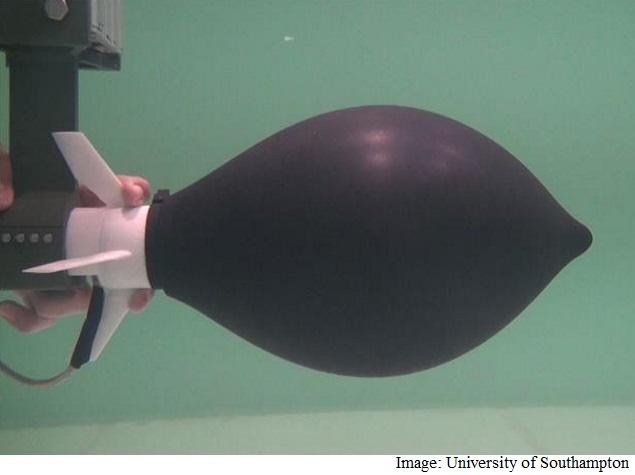- Home
- Science
- Science News
- 3D Printed Octopus Robot Developed With Ultra Fast Propulsion
3D-Printed Octopus Robot Developed With Ultra-Fast Propulsion

Scientists from the University of Southampton, Massachusetts Institute of Technology (MIT) and the Singapore-MIT Alliance for Research and Technology built a deformable octopus-like robot with a 3D-printed skeleton with no moving parts and no energy storage device other than a thin elastic outer hull.
The 30cm long self-propelling robot is inflated with water and then rapidly deflates by shooting the water out through its base to power its outstanding propulsion and acceleration.
As the rocket contracts, it can achieve more than 2.6 times the thrust of a rigid rocket doing the same manoeuvre.
It works like blowing up a balloon and then releasing it to fly around the room. However, the 3D-printed polycarbonate skeleton inside keeps the balloon tight and the final shape streamlined, while fins on the back keep it going straight.
The robot is capable of accelerating up to ten body lengths in less than a second.
In recent laboratory tests, the robot accelerated a 1kg payload up to 9kmph in less than a second.
This is comparable to a mini-cooper carrying an additional 350kg of weight (bringing the total weight of the car to 1,000kg) accelerating from a standstill to 96kmph in one second - underwater.
This performance is unprecedented in man-made underwater vehicles, researchers said.
"Man-made underwater vehicle are designed to be as streamlined as possible, but with the exception of torpedoes, which use massive amounts of propellant, none of these vehicles achieve speeds of even a single body length per second or accelerations of 0.1g, despite significant mechanical complexity," said Dr Gabriel Weymouth, lead author of the study.
"Rigid bodies always lose energy to the surrounding water, but the rapidly shrinking form of the robot actually uses the water to help propel its ultra-fast escape, resulting in 53 percent energy efficiency, which is better than the upper estimates for fast-starting fish," said Weymouth, Lecturer for the Southampton Marine and Maritime Institute at the University of Southampton.
The researchers calculated that making the robot bigger would improve its fast-starting performance, which could have applications in the development of artificial underwater vehicles that can match the speed, manoeuvrability and efficiency of their biological inspirations.
The study is published in the journal Bioinspiration and Biomimetics.
Catch the latest from the Consumer Electronics Show on Gadgets 360, at our CES 2026 hub.
Related Stories
- Samsung Galaxy Unpacked 2025
- ChatGPT
- Redmi Note 14 Pro+
- iPhone 16
- Apple Vision Pro
- Oneplus 12
- OnePlus Nord CE 3 Lite 5G
- iPhone 13
- Xiaomi 14 Pro
- Oppo Find N3
- Tecno Spark Go (2023)
- Realme V30
- Best Phones Under 25000
- Samsung Galaxy S24 Series
- Cryptocurrency
- iQoo 12
- Samsung Galaxy S24 Ultra
- Giottus
- Samsung Galaxy Z Flip 5
- Apple 'Scary Fast'
- Housefull 5
- GoPro Hero 12 Black Review
- Invincible Season 2
- JioGlass
- HD Ready TV
- Laptop Under 50000
- Smartwatch Under 10000
- Latest Mobile Phones
- Compare Phones
- Honor Magic 8 RSR Porsche Design
- Honor Magic 8 Pro Air
- Infinix Note Edge
- Lava Blaze Duo 3
- Tecno Spark Go 3
- iQOO Z11 Turbo
- OPPO A6c
- Samsung Galaxy A07 5G
- Lenovo Yoga Slim 7x (2025)
- Lenovo Yoga Slim 7a
- Lenovo Idea Tab Plus
- Realme Pad 3
- Moto Watch
- Garmin Quatix 8 Pro
- Haier H5E Series
- Acerpure Nitro Z Series 100-inch QLED TV
- Asus ROG Ally
- Nintendo Switch Lite
- Haier 1.6 Ton 5 Star Inverter Split AC (HSU19G-MZAID5BN-INV)
- Haier 1.6 Ton 5 Star Inverter Split AC (HSU19G-MZAIM5BN-INV)






![[Sponsored] Haier C90 OLED TV | Dolby Vision IQ, 144Hz OLED and Google TV in Action](https://www.gadgets360.com/static/mobile/images/spacer.png)









